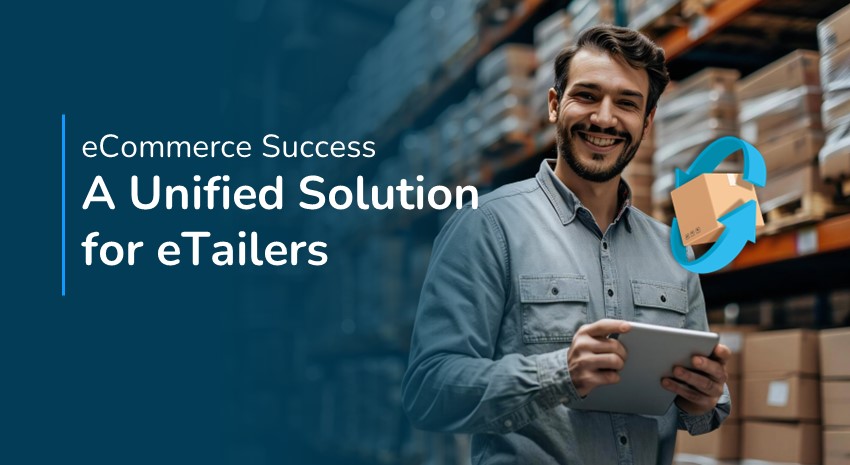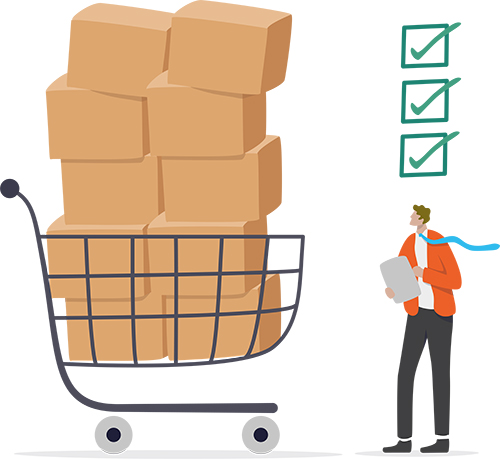eTailers Integrate Online Stores and Back Office Operations for eCommerce Success

eCommerce state of the market
eCommerce has been steadily growing for years. The COVID pandemic spurred many businesses to accelerate their plans to open or expand their online stores.
Online retail has become so pervasive that the trend has spawned a new term: eTailer. An eTailer is a company that earns a significant percentage of its income from online sales, whether through websites or marketplaces.
This article discusses how eTailers can overcome many of the challenges facing them and achieve eCommerce success through a unified solution that integrates their online stores and back office operations.

The explosion of online sales
eCommerce worldwide is expected to grow from over $5 trillion in 2021 to over $8 trillion in 2026. In the US, online retail sales topped $1 trillion in 2023 alone. The same year, B2B online sales in the US were more than $2 trillion.
Manufacturers, businesses that traditionally sell to other businesses, found their distribution channels limited or shut down entirely due to the pandemic and quickly retooled their online presence to sell directly to their customers, joining many other companies already in the direct-to-consumer (DTC) online market.
As a result, DTC has become the third most popular online sales channel in the U.S. and is expected to exceed $200 billion by 2024. One factor driving these sales is that almost 60% of consumers prefer visiting manufacturers’ websites because of the broader product selection. According to Big Commerce, “Since retailers often only sell the most popular styles and colors, customers can shop straight from the manufacturer to gain access to the entire collection.”
Business-to-Business (B2B) eCommerce in the US accounted for $2.1 trillion, or 14% of all B2B sales in 2023
Digital Commerce 360, B2B eCommerce Market (Feb 7, 2024)

Problems faced by eTailers
While most companies, from retailers to manufacturers to distributors, would greatly benefit from including online sales as part of their business model, implementing and maintaining an online sales presence presents some challenges, including:

Multiple target audiences
It’s important for eTailers to tailor their online presence according to their target audience and brand strategy, for example:
- Brand Segmentation: Companies with multiple brands targeting different market segments may opt for separate websites for each brand or a single website showcasing all their brands. This decision depends on the desired brand perception and audience targeting strategy.
- Distributor vs. Retail vs. Consumer Focus: Manufacturers might need separate websites or logins for their distributors, retailers, and end consumers to cater to their distinct needs, pricing structure, and purchasing behaviors.
- White Labeling: If a manufacturer sells products under white label agreements (i.e., allowing other companies to sell products under their own branding), they might require a separate online presence for those sales to maintain clarity and coherence in their overall brand strategy.
- Multi-channel Marketing: Companies selling the same product across multiple websites or sales channels might need to customize their marketing content and imagery for each channel to optimize their impact and resonance with the target audience.

Marketplaces vs. Websites
When it comes to selling your product online, you have plenty of options. Broadly speaking, you can choose between selling on marketplaces or having your own website. However, you’re not restricted to just one route. Depending on your product and goals, selling on multiple marketplaces and having several dedicated websites could be a good idea.
Marketplaces
Marketplaces allow multiple vendors to sell through a single online presence. Examples include Amazon, Walmart, Etsy, and eBay. Marketplaces typically:
- Charge multiple fees per transaction for using their platform.
- Offer warehousing and fulfillment services for a fee
- Can potentially deliver your products faster while saving on shipping costs
- Offer competitor’s products
Each marketplace has its own requirements and fee structure.
For example, Amazon charges a fee as a percentage of the price, a fee based on the type of seller you are, and additional fees if you use Amazon for inventory, fulfillment, account maintenance, or any of their other services.
Walmart, on the other hand, does not charge a fee to be listed but does charge a referral fee ranging from 6-15% on all transactions. Walmart also offers fulfillment for a fee. In addition, Walmart requires its sellers to use EDIINT AS2 (Electronic Data Interchange over the Internet – Applicability Statement 2) for secure data exchange of funds.
To ensure profitability, sellers must perform due diligence to understand and effectively manage these fees and requirements for each marketplace.
Websites
Marketplaces offer many benefits but can be restrictive in how retailers display their products. Companies can choose instead to administer their own eCommerce presence on a dedicated website, which gives them more flexibility than marketplaces. For example, they can control the site’s look and feel and how their products are displayed. Dedicated eCommerce websites fall into two broad categories: hosted websites and self-managed websites.
- Hosted websites are turn-key sites available by subscription from an eCommerce hosting provider like Shopify and Big Commerce. The advantage of hosted eCommerce sites is that they make it easy to quickly spin up a new website and begin selling your products with little to no technical knowledge.
- Self-managed websites are sites that you build and support yourself. You handle configuring and maintaining the site, designing the user interface, ensuring products are correctly displayed, setting up payment gateways, handling order fulfillment promptly, and more. The advantage of self-managed websites is that you fully control your online presence. Examples are WooCommerce and Adobe Commerce (formerly Magento). These applications often provide templates to make it easier for you to create user interfaces and more.
Marketplace or Website: Which is best?
Marketplaces and websites each have their place. Here are a few advantages for each:
Advantages of marketplaces
- Marketplaces typically have more traffic due to their higher brand identity. When potential customers want to buy a product like yours, they will typically head to a marketplace first.
- Marketplaces provide many convenient services, such as managing inventory, fulfillment, and returns, so you can focus on your business.
- Marketplaces accept and manage multiple payment options for you.
- Marketplaces advertise on a larger scale than most individual eTailers can afford.
- Marketplaces allow sellers to use geographically dispersed warehouses for rapid delivery of their orders.
Advantages of a dedicated website
- With a marketplace, you are just one of a crowd of competing companies selling the same type of product. A website lets you define your own look and feel and select the products you want to promote.
- You control your own inventory and fulfillment, which allows you to provide a personal touch to your product.
- Managing your own warehousing, fulfillment, and payments lets you save on the many fees marketplaces charge for those services.
Many eTailers choose a combination of both marketplaces and websites to maximize their chances of being seen while still offering options for a branded buying experience.
Nearly 60% of consumers prefer to visit manufacturers’ websites because of their extensive product selection
Business Insider – Consumers Are Buying Directly from Brands (2021)

Payment processing
Providing a hassle-free online experience helps promote repeat business. Payment processing must be secure, fast, and easy for your customer. Most marketplaces and eCommerce site providers offer access to secure payment gateways as well as giving you the choice to use your own.
Managing the payment process
Among the issues to consider for payment processing are:
- Which payment options are available? The best scenario is to accept a variety of payment methods including credit cards, debit cards, electronic options like Google Pay and ApplePay, ACH, and more.
- When is payment expected – settle on acceptance vs. settle on shipment?
- How are items like gift cards and loyalty points handled?
- What security measures are in place to protect you and your customers? Ensuring payment security and compliance with industry standards such as PCI-DSS (Payment Card Industry – Data Security Standard) is essential to protect customer payment data from unauthorized access, breaches, and fraud.
Getting paid
Another issue is how you will get paid. If you are using multiple websites and marketplaces, each will have different ways to complete transactions, settle payments, show available inventory, and transfer funds to you. Your internal systems (financial management, inventory management, CRM, and fulfillment systems) must integrate with all your eCommerce sites to track transactions and settle payments accurately.

Pricing
What a company charges for its product can vary based on many factors, from simple discounts to warehouse-clearing fire sales. Finding the optimal price point can be challenging: You are trying to maximize profit per sale (by increasing the selling price) while maximizing the number of sales (by decreasing the selling price).
In addition to the price you charge, other factors to consider are how to handle discounts, frequent buyer points, and quantity discounts.
A word of caution: Selling products through multiple channels can lead to channel conflicts if pricing strategies are not aligned and managed properly (different prices will appear on different sites).

Inventory and warehousing
Online purchases will reduce the items available in inventory. Each eCommerce site must integrate with the company’s overall financial and warehouse management systems so website visitors can see how many items remain in stock and the company has accurate inventory tracking for replenishment and forecasting.
Technology infrastructure
Maintaining a scalable technology infrastructure is critical for eCommerce businesses to support website functionality, manage inventory, process transactions, and enhance customer experiences. Investing in eCommerce platforms, content management systems, and technology upgrades is essential to ensure optimal performance and reliability.
As these platforms and the technology that drives them continue to evolve, there will be more opportunities for communication and integration between an eTailer’s various sales channels.

Other considerations
There are many other technicalities to address in online sales, such as:
Returns and refunds
Consumers are accustomed to fast and no-hassle returns. Companies need to develop an established workflow for:
- handling online returns and refunds, including the process the customer will follow to return the item
- how refunds will be provided to the customer
- whether the returned items are added back into inventory once they arrive at the company.
Content and product management
Creating and managing content, product listings, and inventory across multiple eCommerce sites can be challenging. Ensuring accurate, consistent product information while catering to different audiences and platform requirements requires efficient content management strategies.
Sales tax calculations
Calculating the correct sales tax varies by state and municipality, and arriving at the correct figure can be convoluted.
Faceted Search
Faceted search lets your customers look at your products in different sizes, colors, prices, etc. Each platform and marketplace provides faceted search a little differently.
Bundles and upselling opportunities
Customers who select one item might want to know about other complementary items. For instance, a customer wishing to buy a camera might be interested in adding a camera bag or choosing a bundle of accessories to go with the purchase. Every sale is also an opportunity to offer customers a good/better/best choice to sell your product.
Global eCommerce sales reached around $5.8 trillion in 2023 and are expected to surpass $8 trillion by 2027
Statista, Retail eCommerce Sales Worldwide (2014-2027)

ArcherPoint’s unified online sales business solution for eTailers
The issues listed here (and there are many more) are not intended to overwhelm but rather to point out the many moving parts involved in online sales. Each example listed shows why your online sales channels must be able to communicate with your back-office processes to keep track of sales, profitability, and product availability.
ArcherPoint offers eTailers a unified business solution that integrates your financials, inventory, warehouse, and manufacturing with all your online sales platforms, including marketplaces and websites.
Microsoft Dynamics 365 Business Central
We start with Microsoft Dynamics 365 Business Central, one of today’s most flexible Enterprise Resource Planning (ERP) applications. Business Central offers:
- robust financials, including complex multi-national and multi-entity consolidations
- comprehensive inventory, warehousing, manufacturing, and supply chain management capabilities
- integration with Microsoft’s Power Platform that allows you to develop configurable workflows, automation, and AI-driven business intelligence
- seamless integration with Microsoft 365 (Word, Excel, Outlook, Teams), helping your staff be more collaborative and productive
- integration with most business platforms and APIs
- support from a large development community that creates additional functionality to expand Business Central’s capabilities
Integration with your choice of online sales channels
Next, we include Channel Sales Manager (CSM). CSM provides integration from Business Central to multiple online marketplaces and websites, setting up a bi-directional exchange of sales, payments, inventory, and fulfillment data with each.
It also has native support for Adobe Commerce (Magento), Amazon Marketplace, BigCommerce, Shopify, and WooCommerce. CSM also has a flexible API for fast integration with additional online sales channels.
Channel Sales Manager for Amazon also helps eTailers manage Amazon transaction fees.
Payment processing flexibility
We also include Channel Payment Manager, a PCI-compliant payment gateway with native Stripe and Usio support, and an API engine to create new integrations as needed.
Advantages of a unified online sales solutions
By integrating all the components for online sales into Business Central, you don’t have to be concerned about creating one-off integrations to every online store and marketplace. Instead, you have all your financial, warehousing, supply chain, and manufacturing information in one powerful, cloud-based ERP with the ability to communicate with all your online stores so they always reflect the current product description, price, and product availability.
You can:
- add new companies and eCommerce sites quickly
- accept multiple payment types
- have your financials and inventory automatically updated as sales are received and fulfilled
- support a variety of eCommerce models: Business-to-business (B2B), business-to-consumer (B2C), and direct-to-consumer (DTC).
Business Central also has support from a large community of third-party independent software vendors (ISVs) that expand Business Central’s capabilities to include:
- barcoding and scanners
- lot and serial number tracking
- advanced payment options
- shipping and logistics
- advanced inventory and warehouse management
- and Artificial Intelligence (AI) powered business reporting and analytics.
See all 5000+ add-on products for Business Central at Microsoft’s AppSource.

Play the game to win!
If you’re a manufacturer, distributor, or retailer looking to win at online sales, talk to ArcherPoint. Let us show you how the right technology can help you compete and win at eCommerce.
Trending Posts
Stay Informed
Choose Your Preferences
"*required" indicates required fields


